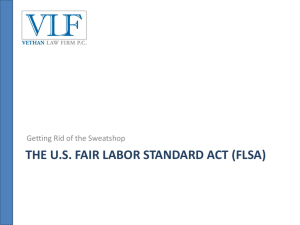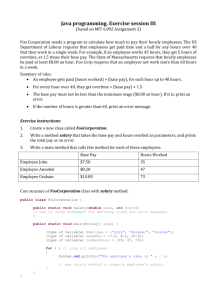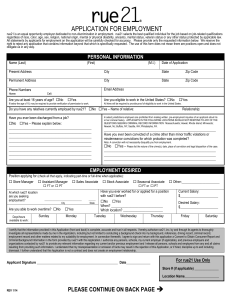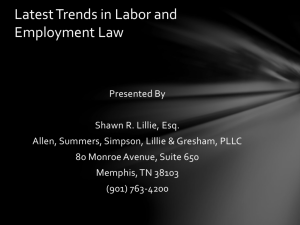Coalition for Ethanol Webinar Series Wage and Hour Traps for the
advertisement
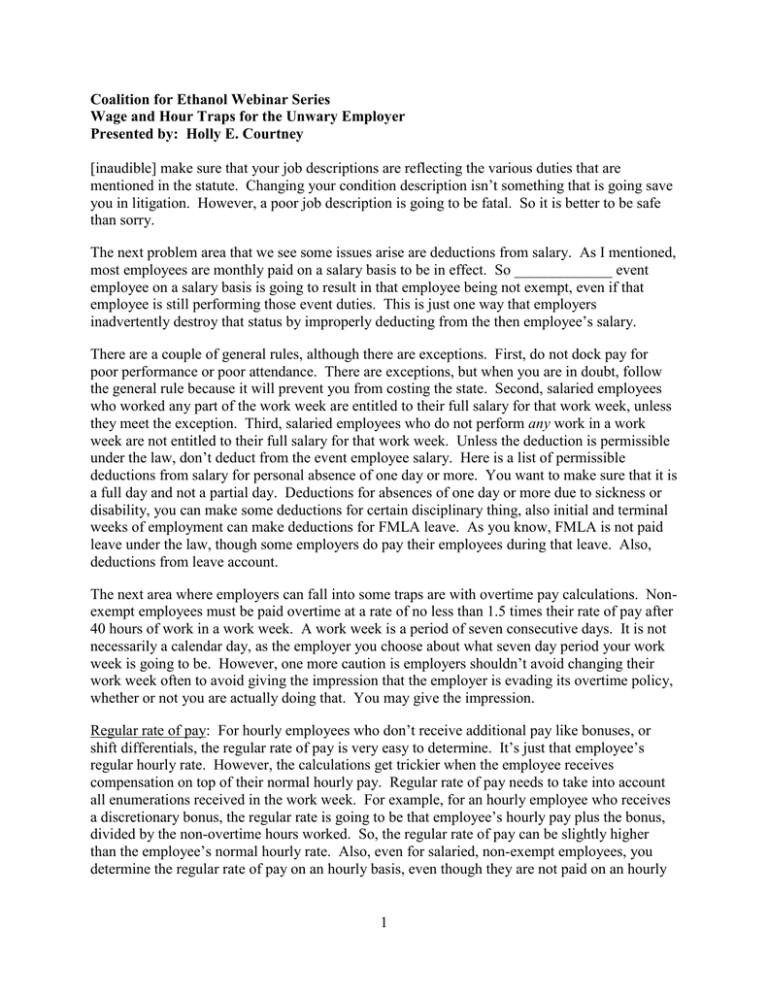
Coalition for Ethanol Webinar Series Wage and Hour Traps for the Unwary Employer Presented by: Holly E. Courtney [inaudible] make sure that your job descriptions are reflecting the various duties that are mentioned in the statute. Changing your condition description isn’t something that is going save you in litigation. However, a poor job description is going to be fatal. So it is better to be safe than sorry. The next problem area that we see some issues arise are deductions from salary. As I mentioned, most employees are monthly paid on a salary basis to be in effect. So _____________ event employee on a salary basis is going to result in that employee being not exempt, even if that employee is still performing those event duties. This is just one way that employers inadvertently destroy that status by improperly deducting from the then employee’s salary. There are a couple of general rules, although there are exceptions. First, do not dock pay for poor performance or poor attendance. There are exceptions, but when you are in doubt, follow the general rule because it will prevent you from costing the state. Second, salaried employees who worked any part of the work week are entitled to their full salary for that work week, unless they meet the exception. Third, salaried employees who do not perform any work in a work week are not entitled to their full salary for that work week. Unless the deduction is permissible under the law, don’t deduct from the event employee salary. Here is a list of permissible deductions from salary for personal absence of one day or more. You want to make sure that it is a full day and not a partial day. Deductions for absences of one day or more due to sickness or disability, you can make some deductions for certain disciplinary thing, also initial and terminal weeks of employment can make deductions for FMLA leave. As you know, FMLA is not paid leave under the law, though some employers do pay their employees during that leave. Also, deductions from leave account. The next area where employers can fall into some traps are with overtime pay calculations. Nonexempt employees must be paid overtime at a rate of no less than 1.5 times their rate of pay after 40 hours of work in a work week. A work week is a period of seven consecutive days. It is not necessarily a calendar day, as the employer you choose about what seven day period your work week is going to be. However, one more caution is employers shouldn’t avoid changing their work week often to avoid giving the impression that the employer is evading its overtime policy, whether or not you are actually doing that. You may give the impression. Regular rate of pay: For hourly employees who don’t receive additional pay like bonuses, or shift differentials, the regular rate of pay is very easy to determine. It’s just that employee’s regular hourly rate. However, the calculations get trickier when the employee receives compensation on top of their normal hourly pay. Regular rate of pay needs to take into account all enumerations received in the work week. For example, for an hourly employee who receives a discretionary bonus, the regular rate is going to be that employee’s hourly pay plus the bonus, divided by the non-overtime hours worked. So, the regular rate of pay can be slightly higher than the employee’s normal hourly rate. Also, even for salaried, non-exempt employees, you determine the regular rate of pay on an hourly basis, even though they are not paid on an hourly 1 basis. You divide the salary by the total number of hours the salary is intended to compensation. This salary can get even more complicated with more non-discretionary bonuses. Just as an example for how to calculate overtime pay: Tom works in the factory, has a base hourly rate of $12 per hour. He often fills in on the third shift and also works on the weekend. By company policy, the company pays his third shift employees a shift premium of $1 per hour. Company also pays employees a $2 per hour bonus on weekends. The company pays Tom overtime at $18 per hour, including those weeks in which he worked the third shift and weekends. Did the company pay the required overtime? Here, no, it did not. They failed to calculate, or add, the shift premium. You need to make sure you are adding all that up to determine the regular rate of pay. Another issue that can arise is where an employer misclassifies a worker as an independent contractor when that worker is an employee. Only employees are subject to FLSA. If you are improperly designating someone as an independent contractor, and they are actually an employee, and you are not calling the various requirements under the FLSA, and the person is also labeled an independent contractor, you can be in big trouble. Again, there are reasons why employers and workers may want to classify workers as independent contractors instead of employees. Generally, the key benefit is a smaller tax bill for both the employer and the employee. Usually the employer will need to pay contributions to certain employment related taxes, and the employee can deduct certain business expenses on their returns. As a general matter, do not assume that employers cannot be liable for FLSA violations committed with respect to workers designated as independent contractors. We need to make sure that under the statute, they are actually considered independent contracts. FLSA in general – what makes common business sense, what’s done in correctness does not always comply with the law. Under the FLSA, to determine whether or not someone is an employee, they use the Economic Reality Test. This is a test that looks to several non-dispositive factors. They key factor is the employer’s degree of control. The more control the employer has over the worker, the more likely they are to be considered an employee and not an independent contractor. The other considerations are the worker’s opportunity for profit and losses, degree of worker’s investment in equipment or materials, whether the job requires special skills to perform, the permanence of duration of the working relationship, and the extent to which the work is an integral part of the employer’s business. Just another warning – having the standard independent contractor agreement is not going to get you off the hook. The test looks at the actual facts and considers all of these factors, and sometimes just the standard agreement won’t be enough. You need to make sure that they are actually performing the type of work an independent contractor would do before ______________________ and such. The last area where employers sometimes fall into a trap are for Off-the-Clock hours. Employees need to be compensated for all hours worked. Generally, if the time is spent for the employer’s benefit, this is considered hours worked and the employee will need to be compensated. So-called “off-the-clock” cases are becoming increasingly prevalent. In these cases employers are being sued for not counting certain time as “hours worked” for purposes of calculating non-exempt employee’s regular and overtime compensation. Difficult situations arise when non-exempt employees work without reporting all of their hours to their employer, particularly when the employer did not authorize such “off-the-clock” work or doesn’t even 2 know it occurred. This is why these off-the-clock hours’ situations are so challenging because many times, the employer doesn’t even know that the employee is working when not supposed to be. There are a few easy things you can do to avoid common off-the-clock mistakes. First, preparatory and concluding activities. If activities are integral and an indispensable part of the job, they have to be counted as hours worked. For example, if an employee has to set-up certain machinery before starting their shift, that employee needs to be compensated for that time. If an employee needs to change into certain safety clothing to do his work, that needs to be counted as hours worked. Second, sometimes issues arise where there is mandatory training and off-duty meeting time. This is a simple thing to fix. If training and off-duty meetings are mandatory, they have to be counted as hours worked. If your employee needs to be there, you need to pay them. Sometimes training in meetings are truly permissible and may not be counted as hours worked. However, be careful of that because more thorough reporting is likely going to be necessary. Another easy to avoid off-the-cuff mistake relates to travel fund. Generally bringing their meeting to and from work does not count as hours’ worked. However, if an employee receives an assignment requiring him or her to travel out of town for the day or more than a day, the employee’s travel time to and from is considered hours worked and they need to be paid for that whole time. If I work in Milwaukee and am assigned to travel to Chicago for the day. I need to be compensated for my travel to and from Chicago. There are just a few common off-the--cuff issues that tend to lead to litigation. This is when an employee is required to finish certain tasks that were not completed during the employee’s work day. If the employee works for the day and doesn’t finish some of his or her work and stays when it is after he is supposed to and do his or her work - that can lead to litigation. A second situation is when an employee needs to work to through his or her unpaid meal and a rest break. Third, unauthorized overtime often can become a problem and lead to litigation. So in all those situations, because the employee is doing something for the employer’s benefit this needs to be counted as hours worked. First things first, a meal and a rest break, although they have regulations covering this, generally the state laws are a bit more employee friendly. Make sure that you are looking to whatever state in which your employees are working. Make sure that you are complying with that state’s meal and rest break requirements. Other than rest break and the meal break, the employers are not required to pay their employees for the bona fide meal break lasting 30 minutes or more. However, the employee must be completely relieved from performing any work duty during that time. If they work at all, the meal break needs to be compensated. Also the rest breaks are usually 20 minutes or less and must be counted towards hours worked. Federal law doesn’t require employers to give these meal and rest breaks. The regulations here just govern whether or not the periods need to be paid or not. For example, ABC Company provides employees with a 30 minute unpaid lunch break. Employees are generally free to use this time for whatever restaurant, [inaudible] except they cannot leave the premises. Two employees, Jim and Karen, usually eat in the lunchroom. Angela and Pam usually eat at their desk and complete some administrative paperwork during their lunch break and an issue arises. Is this company unpaid 3 lunch rule lawful? The answer is a little complicated. Under state law, you wouldn’t have to pay the employee to work on the premises, eating in the lunch break room. They would be completely relieved from duty. You wouldn’t have to pay them for their meal break. However, law firms and other employees that are choosing to get a couple things done at work and just work at their desk while they are eating their sandwich, under FSLA, you need to pay them. If you were in Wisconsin, you would actually have to pay all of those employees for their meal break because under the company policy it didn’t let the employees leave the premises. Under Wisconsin you need to be able to let the employees leave the premises and there are similar rules in other states so just be aware of things like that. There are a lot of possible solutions to these main off the mark tracks. Even if you are going to have the pay the employees for working off the clock, if you treat the employee violations as disciplinary issues, you’re going to help stop the employees working off the clock when they are not supposed to be. Say an employee is working overtime and they are not supposed to. As a company what you can do is you can require all overtime to still be approved in advance by the employee’s supervisor and make clear to the employees that working on unauthorized overtime is a disciplinary issue. Put this in your employee handbook, put it on notice somewhere that employees are aware of it. This can result in disciplinary action. As the employer actually treat unauthorized overtime as a disciplinary issue, but if they violate it you still need to compensate them. This is just a way to really make it clear to your employees that they can’t be working overtime and stop them from doing so. Also, regarding employees that are working through their meals when they are not supposed to be, just make sure they are not being assigned any tasks to be performed outside of normal working hours. Make sure that they know that they cannot work during their unpaid meal period and if you do not do that and they are working you will have to pay them. Overall to be sure the problems discussed today are not the only FSLA state problem areas. As long as there are different state laws that make even more employee protected that you should be aware of. In any event, taking steps and minimize FLSA litigation is essential to avoid complicated costly defensive FLSA claims. Thank you for joining the Michael Best & Friedrich Webinar “Wage and Hour Traps for the Unwary Employer”. 099999-0952\14675566.1 4

